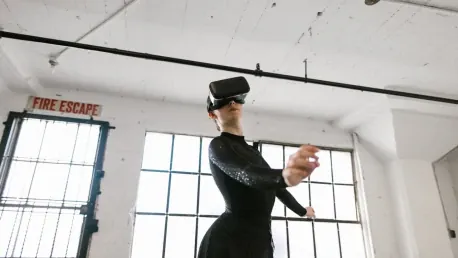Canon, known for its expertise in optics and imaging, has recently taken a significant step into the augmented reality and virtual reality market with its new patent application US20230099286A1. This patent outlines the design and functionality of lightweight and compact VR/AR glasses, positioning them towards mass-market accessibility and practical usage, in stark contrast to Apple’s high-end Vision Pro. Canon’s entry into AR/VR aims to bridge the gap between advanced optics and user comfort, offering an alternative that could potentially appeal to a broader audience. As Apple’s Vision Pro, priced at a steep $3,499, aims at a niche market of tech enthusiasts and professionals, Canon’s strategy appears to cater to a wider demographic with a more practical and cost-effective solution.
Canon’s Strategic Entry into AR/VR
Canon’s new patent reveals a meticulously designed AR/VR system focused on optical precision and user comfort. In an industry where devices often suffer from bulk and cumbersome interfaces, Canon’s approach uses an advanced arrangement of lenses and displays to create a more compact and comfortable experience. The focus on optics over heavy computational needs suggests a product that could be more affordable and adaptable to a broader audience. Canon’s entry into AR/VR comes at a time when there is significant criticism of existing high-end devices for their high costs and limited practical uses, even as they capture the imagination with their futuristic capabilities.
Apple’s Vision Pro is identified as a luxury mixed-reality headset designed primarily for tech enthusiasts and professionals. However, its $3,499 price tag and advanced features have faced criticism for being impractical for anything beyond standalone usage. This creates a unique opportunity for Canon to capture an untapped market with a product that leverages its well-known optical expertise while addressing user comfort and cost efficiency. By presenting a more practical and affordable alternative, Canon aims to fulfill the unmet needs of a larger demographic, distinguishing its AR/VR glasses from the premium-focused Apple Vision Pro.
Leveraging Canon’s Established Ecosystem
A crucial aspect of Canon’s strategy with its AR/VR glasses is leveraging its established ecosystem. Unlike Apple’s Vision Pro, which stands as a premium, standalone device, Canon’s AR/VR glasses have the potential to integrate seamlessly with existing Canon products. For professionals in filmmaking, for instance, Canon’s AR glasses could serve as live-view monitors during film production, allowing for real-time shot visualization and enhanced workflow on set. This integration with Canon’s existing tools can lead to a more coherent and productive environment for users already invested in Canon’s ecosystem.
Beyond filmmaking, integration with Canon’s interchangeable lenses would enable users to visualize lens effects in a virtual environment, benefiting photographers and cinematographers alike. The strong synergy between Canon’s new AR/VR glasses and its established suite of products could reinforce its product utility in professional settings. Furthermore, Canon’s established presence in medical and industrial applications hints at extensive use in enhanced precision for diagnostics, engineering practices, and training simulations, offering a vast range of improvements in specialized and professional fields through augmented reality.
Professional Utility Beyond Entertainment
From a professional perspective, Canon’s ecosystem provides the glasses substantial utility beyond entertainment. Canon’s edge in creating cohesive systems of tools is evident through potential applications in various professional fields. By providing AR/VR glasses tailored to work in harmony with its other products, Canon can offer integrated solutions for fields such as medical imaging, where precision and real-time data visualization are critical. This strategic positioning highlights Canon’s capability to serve a broad spectrum of users needing practical and reliable tools for their professions.
Criticism directed at Apple’s Vision Pro has highlighted its prohibitive price and restricted real-world application scope. Furthermore, extended headset use has raised concerns about health implications, including headaches, eye strain, and potential neurological effects. Canon’s focus on ergonomic design and visual clarity seeks to mitigate these issues, making the glasses a healthier alternative for prolonged use. By designing glasses that maintain clarity and comfort, Canon addresses criticisms leveled against other high-end AR/VR devices. Avoiding what critics call “Zombieland-style detachment,” Canon’s emphasis on user experience and well-being could help establish a positive reputation for its AR/VR product in the market.
Addressing Market Gaps and Potential Risks
Canon’s strategic efforts appear to avoid many pitfalls encountered by Apple’s Vision Pro. Emphasizing affordable optics over heavy computing power allows Canon to produce a more cost-efficient product with mass-market appeal. The potential for modular functionality enables Canon’s glasses to complement existing devices rather than function as standalone units, enhancing their professional utility for specific user groups, such as filmmakers and photographers. By offering a practical and financially accessible AR/VR option, Canon stands poised to address significant gaps left by Apple’s Vision Pro and potentially drive positive changes in the AR/VR landscape.
Despite the positive anticipation surrounding Canon’s approach, some risks remain. Canon’s prioritization of a simpler feature set over advanced spatial computing could potentially undermine the ‘wow factor’ associated with futuristic AR/VR experiences. Furthermore, the competitive edge against Apple will significantly rely on the quality of Canon’s software and overall user integration. The seamlessness of the user experience will be a critical determinant in Canon’s success. The ability to deliver a user-friendly, integrated system – one that aligns well with Canon’s ecosystem while providing robust support and functionality – will be vital in establishing Canon’s AR/VR glasses as a strong contender in the market.
Canon’s Vision for the Future of AR/VR
Canon, renowned for its expertise in optics and imaging, has recently made a notable foray into the augmented reality (AR) and virtual reality (VR) market with its new patent application US20230099286A1. This patent details the design and operational aspects of lightweight and compact AR/VR glasses. Canon aims to make these glasses accessible to the mass market and practical for everyday use, offering a stark contrast to Apple’s high-end Vision Pro. Apple’s Vision Pro, with a hefty price tag of $3,499, targets a niche audience of tech enthusiasts and professionals. Conversely, Canon’s approach is to bridge the gap between advanced optical technology and user comfort, aiming to provide a cost-effective alternative that appeals to a broader audience. Canon’s new glasses signify their strategy to cater to the general public, making sophisticated AR/VR experiences more affordable and user-friendly. This move could significantly broaden the accessibility of AR and VR technologies, positioning Canon as a key player in the consumer market.









